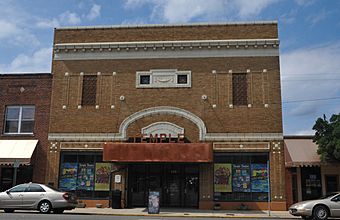Temple Theatre (Sanford, North Carolina) facts for kids
Quick facts for kids |
|
|
Temple Theatre
|
|
|
U.S. Historic district
Contributing property |
|

Temple Theatre, March 2007
|
|
| Location | 120 Carthage St., Sanford, North Carolina |
|---|---|
| Area | 0.1 acres (0.040 ha) |
| Built | 1925 |
| Built by | Joe W. Stout Co. |
| Architect | Flanagan, Eric G. |
| Architectural style | Colonial Revival, Modern Movement |
| NRHP reference No. | 83001895 |
| Added to NRHP | September 8, 1983 |
The Temple Theatre is a cool old building in Sanford, North Carolina. It's a place where people go to watch plays, concerts, and other fun shows. Robert Ingram, Sr. built it in 1925. Back then, Sanford was a much smaller town. The theatre got its name "Temple" because it was right next to the town's Masonic Lodge.
When it was built, a newspaper said that no money was spared to make it a modern and amazing playhouse. The building is made of brick and has two floors. It mixes two cool styles of building design: Colonial Revival and Art Deco.
History of the Temple Theatre
For many years, the Temple Theatre was the main place for entertainment in Lee County, North Carolina. It was close to the train station, so it often hosted popular Vaudeville shows. Vaudeville was a type of entertainment with many different acts, like singers, dancers, and comedians.
From Movies to Community Plays
Later, in the 1930s, the Temple Theatre became a place for touring shows. After that, it turned into a movie theater. In the 1960s, local groups like the Sanford Little Theatre used the Temple for their plays. But in 1965, the Temple Theatre closed its doors.
Bringing the Theatre Back to Life
The Temple Theatre started a new chapter in 1981. Robert Ingram, Jr., whose dad built the theatre, gave the building to the people of Lee County. Thanks to Sam Bass, the building was added to the National Register of Historic Places in 1983. This helped it get a big grant from the North Carolina Legislature.
Local people and businesses also helped by matching the grant money. The building was fixed up, and in 1984, the Temple Theatre reopened as a community theater. The first show was a musical called Chicago.
Becoming a Professional Theatre
In 1987, the Temple Theatre started producing professional shows. This meant they paid the actors and crew. Over time, the theatre grew and hired more professional staff. By 1990, the Temple Board decided to pay actors for all shows during the regular season. This made the Temple a professional theatre, though some local actors still volunteered.
Improvements and Modern Updates
The theatre has had many updates over the years. In 1998, the roof was completely replaced. The seating area was also changed to make it more comfortable for guests. The theatre now has modern sound and lighting systems. These systems help make every show amazing.
The lobby of the theatre is beautiful, with colorful floor tiles and a sparkling crystal chandelier. Upstairs, you can see the restored tin ceiling. Backstage, performers have comfortable dressing rooms and a lounge. The theatre also has an orchestra pit for musicians, which can be covered to make the stage bigger. The design of the theatre means that the sound, or acoustics, is excellent, and everyone has a great view of the stage.
The Temple Theatre is a very important cultural spot in Lee County. Many famous artists and groups have performed there, including the North Carolina Shakespeare Festival, the Red Clay Ramblers, The Kingston Trio, and the Glenn Miller Band.
Shows and Performances
The Temple Theatre Company puts on six main shows each season. These shows can be anything from musicals to dramas, and each one runs for three weeks. All the actors are paid professionals who come from all over the country.
Comedy and Special Events
The Temple Theatre is also a place for comedy shows. It has hosted many well-known stand-up comedians. Besides plays and comedy, the Temple also has special events like pop concerts and dance recitals.
People from nearby areas like the Research Triangle and the Piedmont Triad often come to the Temple. About 40,000 people visit the theatre every year! The money raised from ticket sales and donations helps keep the theatre running. The Temple Theatre is a non-profit organization, which means it uses its money to support its mission, not to make a profit.
Education Programs
The Temple Theatre offers many chances for young people to learn about performing.
Classes for Young Performers
During the school year, they have different classes. Kids can learn dance (like tap and jazz), acting, and how to audition. These classes help young performers get ready for big shows and even join the Temple Teen Ensemble.
Rising Stars for Younger Kids
For younger children, aged 4 to 7, there's a program called "Rising Stars." These kids work for four weeks to put on their own show!
Temple Teen Ensemble
The Temple Teen Ensemble is a group of almost 20 talented teenagers, aged 13 to 18. These teens perform songs around the Sanford area. They have different sets of songs for holidays like Halloween and Christmas, or even love songs. Their main goal is to tell people about the main shows happening at the theatre. They often perform a song from each main stage musical to get people excited about coming to see the full show.



